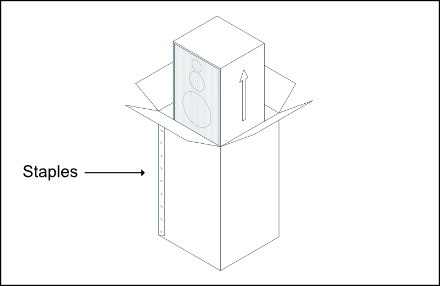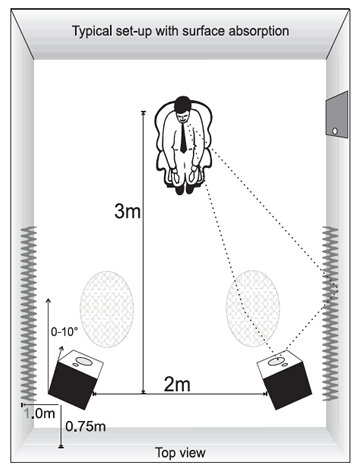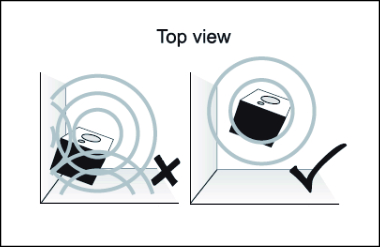Every Harbeth model benefits from thoughtful installation, so may we suggest that you take some time to read this guide before beginning the installation process.
It is a sensible precaution to remove jewellery and belts to negate the risk of scratching the speaker’s finish during unpacking.
Before you attempt to lift the speakers from their cartons please take note of the staples running top to bottom along one edge of the carton. Keep an eye on where they are as you lift out the speaker from the carton! Open the carton’s top flaps, remove the packing cap and take care to avoid contact between the staples and speaker cabinet as you withdraw the speaker in its protective bag.
The Monitor 40s are very heavy and we strongly suggest that they are unpacked in the room in which they are to be used by two people working together.

Lift vertically
Harbeth speakers are at their best when used off the floor and as far as possible away from adjacent surfaces, on stands made from non-resonant material. The top-plate of the stands must be adequately large and the stands themselves stable to prevent the speakers from toppling over. Speaker stands are often fitted with sharp spiked feet that further improve stability.
Note: we recommend felt or rubber dots as an interface between the bottom of the speakers and the top of the stands. If you must use Blu-tack or similar, use the absolute minimum quantity in very small balls not much bigger than grains of rice as it can permanently bond with the veneer.
Ideally, the stands should place the tweeter about level with your ear when seated at your usual listening position — the so-called reference axis’ — where the frequency response is optimised for perfect integration of the sound waves from the drive units. Few users will be able or willing to raise their speakers (or lower their seats) to replicate the laboratory perfection of listening on the reference axis, so there is always a compromise involving the aesthetics of tall stands the technically ideal listening height and stand stability.
Some users prefer both speakers toed-in towards the listening seat by a few degrees. Adjusting the toe-in alters the balance between the mid and high frequencies arriving directly at your ear versus those reflected off walls on either side of the speaker.
Harbeths are designed to present an ‘easy’ electrical load to the amplifier and will work well with solid-state amplifiers. Tube amplifiers are influenced by the electrical load of loudspeakers and we cannot accurately determine in advance how they will perform with any particular loudspeaker.
Playing loud in a large acoustically dry, well-furnished room will demand a powerful amp. Conversely in a small setting listening closer to the speakers, much less power will be needed. As an approximation for normal domestic daytime listening, an amplifier of about 45W into 8ohms per channel rating is a good choice, and 100W into 8 ohms per channel will provide a welcome reserve of power for the louder musical passages in bigger rooms.
Be aware that many amplifiers regardless of output power rating have high input sensitivity, which when driven by an energetic source can drive the amplifier into input-stage saturation, with loss of fidelity. Also, amplifiers with limited output power capability will run out of power and into signal clipping when driven hard, resulting in reduced musical dynamics and potential damage to loudspeaker drive units which is not covered under our warranty.
Note: The amplifier’s performance can change over time, and it should ideally be tested and serviced periodically.
The amplifier’s volume control works much like a zoom lens and brings the performers closer to you as replay loudness increases. Every sound recording has an optimum replay loudness, and that loudness displays the recorded tonal colours in their intended proportion. Listening at home at a loudness of around 70-80dB is considered a safe long-term hearing exposure level by health experts. So we’ve designed Harbeth speakers so they sound natural even when played relatively quietly.
Important Safety Notice
All connections should be made with the audio equipment switched off. Do not touch together the speaker connectors, even briefly.
It is extremely important to connect your Harbeths with the proper phase relationship between the left and right channels. Wiring your speakers is much simpler if you select a clearly colour-coded cable where the ‘hot’ (+) or ‘cold’ (-) conductors are unmistakably identified by colour, rib or printed stripe running along the sheath. Some cables only have a faint coloured identifier printed infrequently, so please take care to identify the correct connectors. Incorrect connections will make natural sound reproduction impossible and could damage your amplifier. Always recheck the wiring before powering up the system after making any changes.

Standard method of setup with 4mm push-fit connectors.
In some countries, the use of 4mm banana plugs is considered a potential safety hazard. You should ensure that banana plugs are suitably safe for children or other persons.
As an alternative, you can use spade connectors or with care, bare wire ends if the surplus wire is neatly trimmed.
Your dealer can provide best advice in connecting your speakers, as can the Harbeth User Group.
A sonic compromise should be reached between placing the speakers near walls or positioned farther out in the listening area. When a loudspeaker is close to a boundary wall (floor, wall, ceiling or corner) the speaker becomes ‘acoustically coupled’ to the surfaces, just as if it is attached to it. The speaker would then no longer operate in free space with a predictable frequency response, but with a sound output that is elevated in the low-mid frequency range. Well stocked bookcases behind or beside speakers can greatly improve the quality of low frequency as can an asymmetrical placement of the speakers in the room.

Here is the typical set-up in a normal living room. The side walls have been optionally treated with sound absorption panels or heavy curtains.
Some listeners say that the most natural sound-stage is achieved when the speakers are somewhat closer to each other than they are away from the listener (above) – please experiment for yourself to see what sounds best to you.
Optimising your speakers in your room needs experimentation but the general rule is the more absorption in the room, the less the room influences the overall reproduced sound. Parallel surfaces such as opposite walls, floor, and ceiling encourage and sustain certain musical notes. Flexible plasterboard walls and wooden floors over cavities such as a basement or garage may resonate and cause a boom.
Echoes or reflections can be readily identified by moving around your room and loudly clapping your hands as you listen to the sound decay into silence. In the middle and upper frequencies, soft-fabric treatments are an easy solution to damping a ‘live’ room. Progressively add absorption and listen again until there are no obvious acoustic issues; don’t overdo sound damping – add just enough to tame reflections and no more!

Right speaker near corner
Curtains, thick carpets, rugs, and bookcases strategically positioned to minimise reflections in the room can make a dramatic improvement in fidelity. Pleated curtains on tracks across windows or side walls are an excellent way of temporarily adjusting room acoustics.
Tone controls and modern digital signal-processing room correction systems can, when used carefully, offer an effective solution to getting the best sound in your room, especially in the lower frequencies where domestic rooms have little absorption. Mid and upper frequencies are best treated with conventional soft materials.
To maintain your speakers, occasionally wipe over the wood with a slightly damp cloth rinsed in a dilute detergent suitable for wood veneer. Please avoid direct sunlight, radiators, draught, smoke, ozone and other chemicals on or near the cabinets.
The protective Harbeth grilles should be fitted during listening; lightly brush them with a soft, dry paintbrush. Caution: Do not press or touch the drive units under or through the grille and do not carry or move the speakers pressing the grille onto your chest.
If necessary the bass unit can be cleaned after removing the grille with a photographer’s air-brush, never a cloth. Do no clean the tweeter units.
Please do not allow objects to impact any of the panels of your loudspeakers as they will leave a permanent bruise in the veneer surface. You should expect that the veneer colour of your speakers will mature with the passing of time.
Note: Care must be taken when removing the attached grilles to avoid marking or damaging the cabinets. They are snugly fitted to the cabinet and under normal circumstances can be teased out by pinching the cloth around the perimeter. We also offer a magnetic Grille Puller Tool, or you can use your own strong magnets to help remove the steel frame.
Thanks to rigorous quality in design and production, Harbeth speakers will give a long, trouble-free service life if operated at a responsible volume level.
In the event you need to speak with your dealer about your Harbeth loudspeakers, you will need to quote the Serial Numbers and provide evidence of purchase. Only buy from official outlets listed on the Harbeth website.
The ex-factory Warranty can be extended (subject to conditions) by registering your speakers on the Harbeth website.
Finally, thank you; we wish you many great years of satisfying listening.
© All Rights Reserved
Harbeth Audio Ltd., UK
2023
© All Rights Reserved
Harbeth Audio Ltd., UK
2023
© All Rights Reserved
Harbeth Audio Ltd., UK
2023